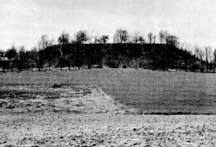
|
||||
|
|
||||
|
|
|
NATIVE AMERICAN STUDIES ARTICLE
Mound Builders
11.01.2000 -- As colonists from the original thirteen colonies gradually spread westward and southward, they found strange earthen mounds, beyond the Alleghenies and in the valley of the Mississippi. These mounds lack beauty and elegance, perhaps. They were mere heaps of earth. Some were colossal, like the Cahokia Mound in Illinois, 100 feet high and covering 16 acres; others were mere blisters rising from the earth. Some stood in solitary grandeur above broad plains, while others sprouted in thick colonies. All were overgrown with trees and shrubbery, so that their outlines could barely be distinguished, although, once cleared, the mounds revealed their artificial nature by their regularity and symmetry of shape. Within many of them were human bones, weapons, tools, and jewelry. There were so many of these earthen heaps--ten thousand in the valley of the Ohio River alone--that they seemed surely to be the work of an energetic and ambitious race. As the settlers fanned outward during the eighteenth and early nineteenth centuries, they found scarcely an area that did not show traces of mound-building activity. The Atlantic coast, from North Carolina up through New England, had no mounds, but beyond the Alleghenies they were everywhere. In the North, the mound zone began in western New York, and extended along the southern shore of Lake Erie into what now are Michigan and Wisconsin, and on to Iowa and Nebraska. In the South, mounds lined the Gulf of Mexico from Florida to eastern Texas, and were found up through the Carolinas and across to Oklahoma. The greatest concentration of mounds lay in the heart of the continent: Ohio, Illinois, Indiana, Missouri. There were lesser mound areas in Kentucky and western Tennessee. Nearly every major waterway of the Midwest was bordered by clusters of mounds. To some of the settlers, the mounds were nuisances to be plowed flat as quickly as possible. To others, they were places of handy refuge in time of flood. But to some, the mounds were the work of a vanished race which had worked with incredible persistence to erect them over the course of thousands of years and then had disappeared from the face of North America. The Indians of the mound area were semi-nomadic peoples, few in number and limited in ambition. They seemed incapable of the sustained effort needed to quarry tons of earth and shape it into a symmetrical mound. These Indians did not have traditions of their own about the construction of the mounds. By the early nineteenth century, hundreds if not thousands of mounds had been examined, measured, and partly excavated by the settlers whose imaginations were stirred by them. These pioneering mound studies revealed the extreme variety in the forms of the earthworks. Along the Great Lakes, the mounds tended to be low, no more than three or four feet high, and took the forms of gigantic birds, reptiles, beasts, and men. These huge image-mounds seemed quite clearly to be of sacred nature--idols, perhaps. Such effigies were common in Wisconsin, Michigan, and Iowa, more rarely seen in Ohio and Missouri, and scarely found anywhere else. To the south, in the valley of the Ohio River, the customary shape of the mounds was conical and their height might be anything from a few yards to 80 or 90 feet. Such mounds seemed to be lookout posts or signal stations, but excavations showed that they always contained burials. Isolated immense, flat-topped pyramid mounds were sometimes found in the Midwest. Some were terraced, or had graded roadways leading to their summits. In the lower Mississippi area, conical mounds were scarce, and flat-topped pyramids were the rule. Their presence in the states bordering the Gulf of Mexico clearly indicated some link between the Aztec culture and that of the builders of the mounds.
Information from "The Mound Builders" by Robert
Silverberg, 1986
|
||
|
|
||||
